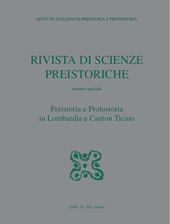Il Basso Verbano nell'Epigravettiano : l'insieme litico di via del Maneggio, Castelletto sopra Ticino (NO)
P. 111-119
In 2003, during the archaeological excavations realized for the recovery of a Golasecca's necropolis located in Castelletto sopra Ticino (NO), Via del Maneggio, and particularly during the excavation of the burial structure called Tomba 1, some flint tools were found. To clarify the significance of these tools, that in no way could have been related with the necropolis, a test pit was made and it led to the identification of an archaeological layer, characterized by the presence of several lithic remains and of a fireplace. The lithic assemblage is composed by 256 flint tools, eight are retouched tools and microliths (among them: 3 microgravettes, 1 end-scraper, 1 truncated blade, 2 fragmented backed edge blades and a trapeze), one microburin and seven cores. Despite several and repeated post depositional phenomena affected the site, the state of preservation of the lithic industry is very good; just a few artefacts show traces of slight alterations, all referred to heat treatment.
All the phases of the knapping sequence are present in the assemblage (from the shaping out to the discard of the cores). The good conservation of the archaeological context is also proved by the great number of refittings in the lithic assemblage. The use-wear analysis, was conducted through the integrated approach between the Low-Power Approach and the High-Power Approach. The results of the use-wear analysis show that in the site were carried out butchering activities and skin working. The characteristics of the lithic assemblage allow to place chronologically the prehistoric occupation of the site in the Late glacial while from a cultural point of view, the site can be attributed to the Epigravettian culture, characterized by lithic industries with a strong tendency to microlithism and by the presence of microgravettes, short end-scrapers and by the appearance of the first geometric microliths.
This interpretation is also supported by the presence of only Pinus sylvestris/montana charcoal in the fireplace, that it was the most widespread three in the area at the time. Although the archaeological record found in the Via del Maneggio site is small, it represents an important turning point in Piedmont prehistoric research because it is the first site of the Upper Paleolithic investigated through a systematic excavation in the region. [Publisher's text]
Forma parte de
Rivista di scienze preistoriche : LXXII, supplemento, 2022-
Artículos del mismo número (disponibles individualmente)
-
Información
Código DOI: 10.32097/1166
ISSN: 2282-457X


